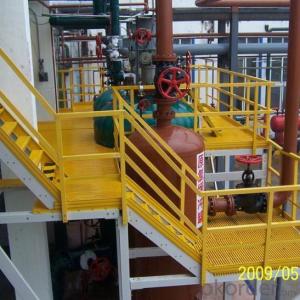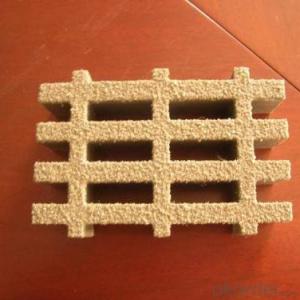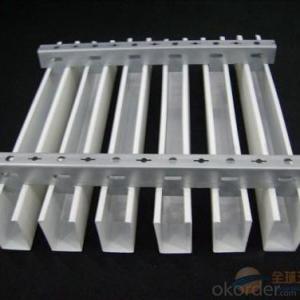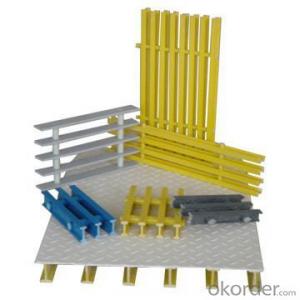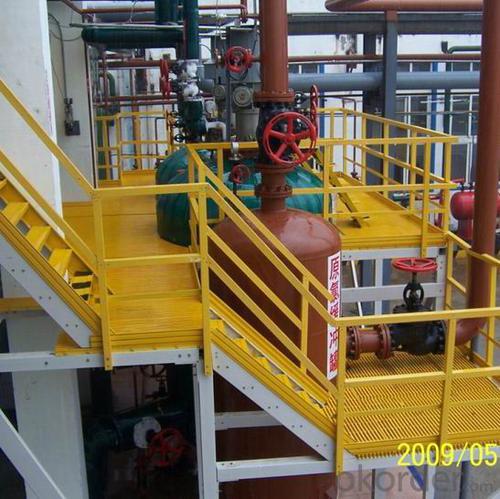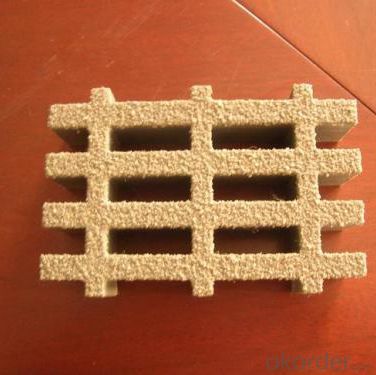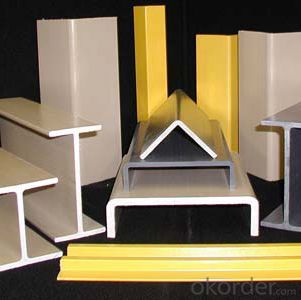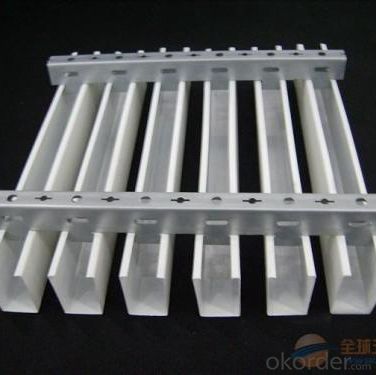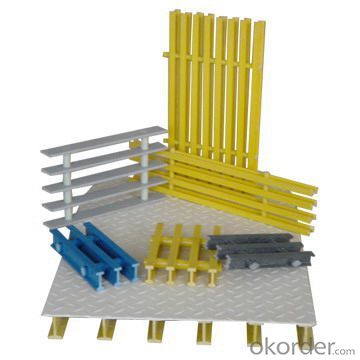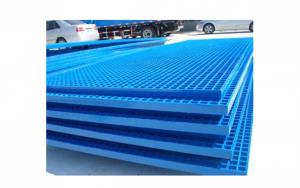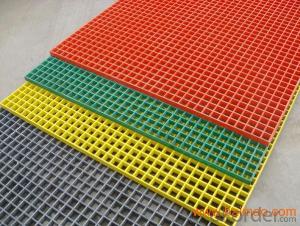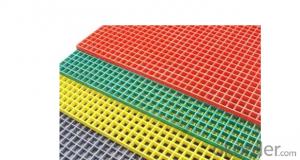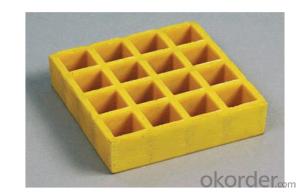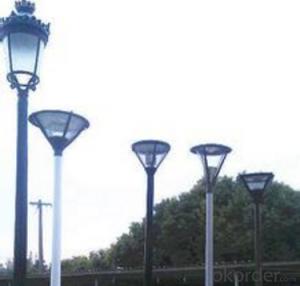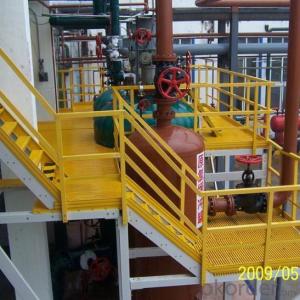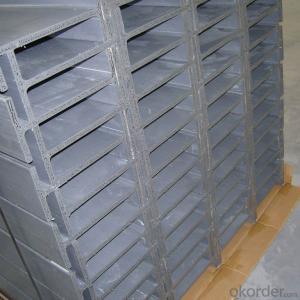FRP Pultrusion Profiles Standard Construction Scaffolding with Platform/Ladder
- Loading Port:
- Tianjin
- Payment Terms:
- TT OR LC
- Min Order Qty:
- 100 m
- Supply Capability:
- 100000 m/month
OKorder Service Pledge
OKorder Financial Service
You Might Also Like
Specification
PRODUCT DESCRIPTION
FRP guardrail are made by assembling of FRP pultrusion profiles. They divided into four types, they are standard square type, economic type, standard round type and heighten type, the type of profile and the installation distance, height, position and quantity can be changed per the customer’s requirement, the color also could be selected according the client’s demand.
FEATURES
a. anti-corrosion, anti-rust
b. light weight and high strength
c. vivid color
d. anti-ageing
e. good property of non-magnetism
f. safety
SPECIFICATIONS
Standard Square type
Handrail | Rung | Post | Kick plate |
Square tube 50*50*4 | Square tube 50*50*4 | Square tube 50*50*4 | Flat panel 101.6*3 |
Economic type
Handrail | Rung | Post | Kick plate |
Channel 57*60*3 | Square tube 38*38*4 | Square tube 50*50*4 | Flat panel 101.6*3 |
Standard round type
Handrail | Rung | Post | Kick plate |
Round tube φ50*4 | Round tube φ50*4 | Round tube φ50*4 | Flat panel 101.6*3 |
Heighten type
Handrail | Rung | Post | Kick plate |
Channel 57*60*3 | Round tube 32*3 | Square tube 50*50*4 | Flat panel 101.6*3 |
PICTURES
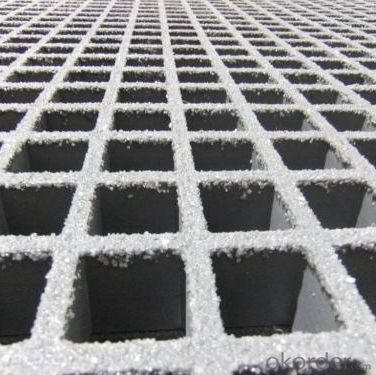
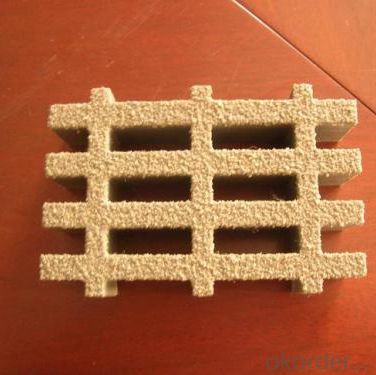
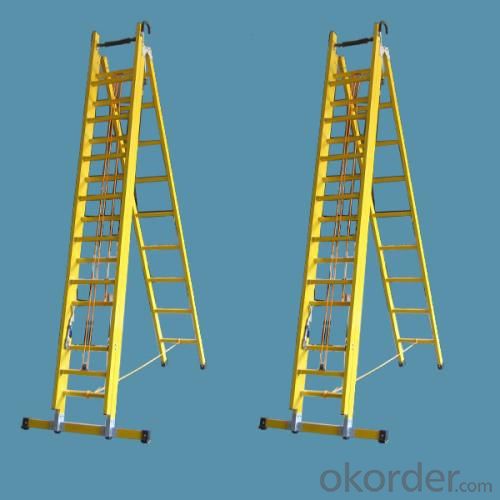
- Q: Are FRP pultrusion profiles resistant to jet fuel?
- Yes, FRP pultrusion profiles are generally resistant to jet fuel.
- Q: What is the maximum length of FRP pultrusion profiles that can be manufactured?
- The length at which FRP pultrusion profiles can be manufactured is influenced by various factors, including the specific manufacturing process, equipment capacity, and transportation limitations. Generally, these profiles can range in length from a few feet to several hundred feet, but there are practical limitations that must be taken into account. Firstly, the size and capacity of the pultrusion equipment used in the manufacturing process often determine the length restrictions of the profiles. Different pultrusion machines have different capabilities, with length capacities varying from a few feet to over 100 feet. Manufacturers must consider the limitations of their available equipment when determining the maximum length they can produce. In addition, transportation and logistical constraints can also impact the maximum length of FRP pultrusion profiles. Longer profiles can be more difficult to transport due to restrictions on road transport, shipping containers, or handling capabilities. These limitations may vary depending on the region, infrastructure, and available transportation methods. It is worth noting that longer profiles may also face challenges in terms of quality control and dimensional stability during the manufacturing process. As the length increases, it becomes more challenging to maintain consistent mechanical properties and effectively control the curing process. Therefore, while there is no fixed maximum length for FRP pultrusion profiles, it is crucial for manufacturers to consider the technical capabilities of their equipment, transportation logistics, and quality control factors when determining the practical limit for the length of their products.
- Q: How do FRP pultrusion profiles perform in coastal environments?
- FRP pultrusion profiles perform exceptionally well in coastal environments due to their inherent resistance to corrosion, moisture, and UV radiation. Thanks to their non-metallic composition, they are not susceptible to rust or degradation caused by saltwater exposure. Additionally, FRP profiles have high strength-to-weight ratios, making them ideal for applications in coastal areas where weight and durability are crucial.
- Q: Are FRP pultrusion profiles resistant to caustic solutions?
- Yes, FRP pultrusion profiles are generally highly resistant to caustic solutions. The inherent chemical resistance of fiberglass-reinforced plastic (FRP) combined with the corrosion-resistant properties of the pultrusion manufacturing process make FRP pultrusion profiles an excellent choice for applications involving caustic solutions.
- Q: What is the fatigue resistance of FRP pultrusion profiles?
- The fatigue resistance of FRP pultrusion profiles refers to their ability to withstand repeated or cyclic loading without experiencing failure or degradation over time. FRP (Fiber Reinforced Polymer) pultrusion profiles are known for their exceptional fatigue resistance compared to other traditional materials such as steel or aluminum. The fatigue resistance of FRP pultrusion profiles can be attributed to the nature of the composite material itself. FRP profiles are typically made by impregnating continuous fibers, such as fiberglass or carbon fiber, with a polymer resin matrix. This combination of fibers and resin creates a material that exhibits high strength-to-weight ratio, excellent corrosion resistance, and superior fatigue properties. The fiber reinforcement in FRP profiles provides them with inherent resistance against fatigue. The continuous fibers distribute and absorb stresses more evenly, preventing the formation and propagation of cracks or defects that can lead to failure. Additionally, the polymer resin matrix acts as a protective layer, shielding the embedded fibers from environmental factors that could degrade their fatigue resistance. The fatigue resistance of FRP pultrusion profiles can be further enhanced through specific design considerations and manufacturing techniques. For example, the orientation and arrangement of the fibers within the profile can be optimized to improve the load-carrying capacity and fatigue life. Additionally, the use of advanced resin systems and manufacturing processes can result in improved interfacial bonding between the fibers and the matrix, further enhancing the fatigue resistance. Overall, FRP pultrusion profiles are renowned for their exceptional fatigue resistance. This makes them an ideal choice for applications that require long-term durability and resistance to cyclic loading, such as infrastructure components, aerospace structures, marine applications, and sporting goods.
- Q: Can FRP pultrusion profiles be customized or tailored to specific project requirements?
- Yes, FRP pultrusion profiles can be customized or tailored to specific project requirements. They can be designed and manufactured in various shapes, sizes, and configurations to meet specific project needs, such as load-bearing capacity, stiffness, corrosion resistance, and thermal properties. Customization options also include adding features like brackets, holes, or reinforcements to ensure the profiles are optimized for the intended application.
- Q: How do FRP pultrusion profiles perform in high-humidity environments?
- FRP pultrusion profiles perform exceptionally well in high-humidity environments. The inherent properties of fiberglass reinforced plastic, such as corrosion resistance and moisture resistance, make these profiles highly durable and resistant to degradation caused by exposure to moisture and humidity. Additionally, FRP pultrusion profiles do not rot, warp, or rust, making them an ideal choice for applications in high-humidity environments.
- Q: Can FRP pultrusion profiles be used in wastewater or sewage treatment plants?
- FRP pultrusion profiles are applicable for use in wastewater or sewage treatment plants. These materials possess exceptional resistance against corrosion, making them an ideal option for environments that frequently encounter chemicals, moisture, and harsh conditions, such as wastewater treatment plants. Compared to conventional materials like steel or concrete, FRP pultrusion profiles offer numerous advantages. They are lightweight, yet incredibly sturdy and long-lasting, facilitating easy installation while maintaining resistance against damage or degradation over time. Additionally, FRP profiles possess non-conductive properties and display good thermal insulation, which can prove advantageous in specific applications within wastewater treatment plants. Moreover, FRP materials exhibit immunity to corrosion and rust, even when exposed to aggressive chemicals and gases commonly present in wastewater or sewage treatment plants. This corrosion resistance significantly prolongs the lifespan of FRP pultrusion profiles, thereby reducing the necessity for frequent maintenance and replacement. To summarize, owing to their corrosion resistance, durability, and other favorable properties, FRP pultrusion profiles are an appropriate choice for a variety of applications in wastewater or sewage treatment plants, including walkways, platforms, handrails, grating, and structural supports.
- Q: Can FRP pultrusion profiles be used in the transportation and logistics industry?
- Yes, FRP (Fiber Reinforced Polymer) pultrusion profiles can be used in the transportation and logistics industry. FRP pultrusion profiles offer several advantages that make them suitable for various applications in this industry. Firstly, FRP pultrusion profiles are lightweight yet extremely strong and durable. This makes them ideal for use in transportation vehicles, such as trucks, trailers, and containers, where reducing weight is crucial for improving fuel efficiency and reducing emissions. Despite their lightweight nature, FRP pultrusion profiles can withstand heavy loads and harsh environmental conditions, ensuring their reliability and longevity. Secondly, FRP pultrusion profiles are highly corrosion-resistant. Unlike traditional materials, such as steel or aluminum, FRP does not rust or corrode when exposed to moisture or chemicals. This makes FRP profiles suitable for use in transportation and logistics applications that involve exposure to corrosive substances, such as saltwater, chemicals, or acidic environments. By using FRP pultrusion profiles, companies can reduce maintenance costs associated with corrosion and prolong the lifespan of their equipment. Additionally, FRP pultrusion profiles offer design flexibility. They can be manufactured in various shapes, sizes, and configurations to meet the specific requirements of transportation and logistics applications. Whether it is for structural components, platforms, flooring, or supports, FRP profiles can be customized to fit different needs, ensuring optimal performance and functionality. Moreover, FRP pultrusion profiles have excellent electrical and thermal insulation properties. This makes them suitable for applications where electrical conductivity needs to be minimized or thermal insulation is required. In the transportation and logistics industry, this can be beneficial for applications such as insulation for refrigerated containers or electrical insulation for specialized vehicles. In summary, FRP pultrusion profiles are well-suited for the transportation and logistics industry. Their lightweight, strong, durable, corrosion-resistant, and customizable nature, along with their electrical and thermal insulation properties, make them a reliable choice for various applications in this sector.
- Q: Are FRP pultrusion profiles resistant to impact?
- Yes, FRP (Fiber Reinforced Polymer) pultrusion profiles are generally resistant to impact. The combination of the high-strength fibers and the polymer matrix used in the manufacturing process makes FRP profiles highly durable and able to withstand significant impacts without cracking or breaking. Additionally, the pultrusion process ensures that the fibers are uniformly distributed throughout the profile, further enhancing its impact resistance. This makes FRP pultrusion profiles ideal for applications where impact resistance is important, such as in construction, transportation, and infrastructure projects.
Send your message to us
FRP Pultrusion Profiles Standard Construction Scaffolding with Platform/Ladder
- Loading Port:
- Tianjin
- Payment Terms:
- TT OR LC
- Min Order Qty:
- 100 m
- Supply Capability:
- 100000 m/month
OKorder Service Pledge
OKorder Financial Service
Similar products
Hot products
Hot Searches
Related keywords
